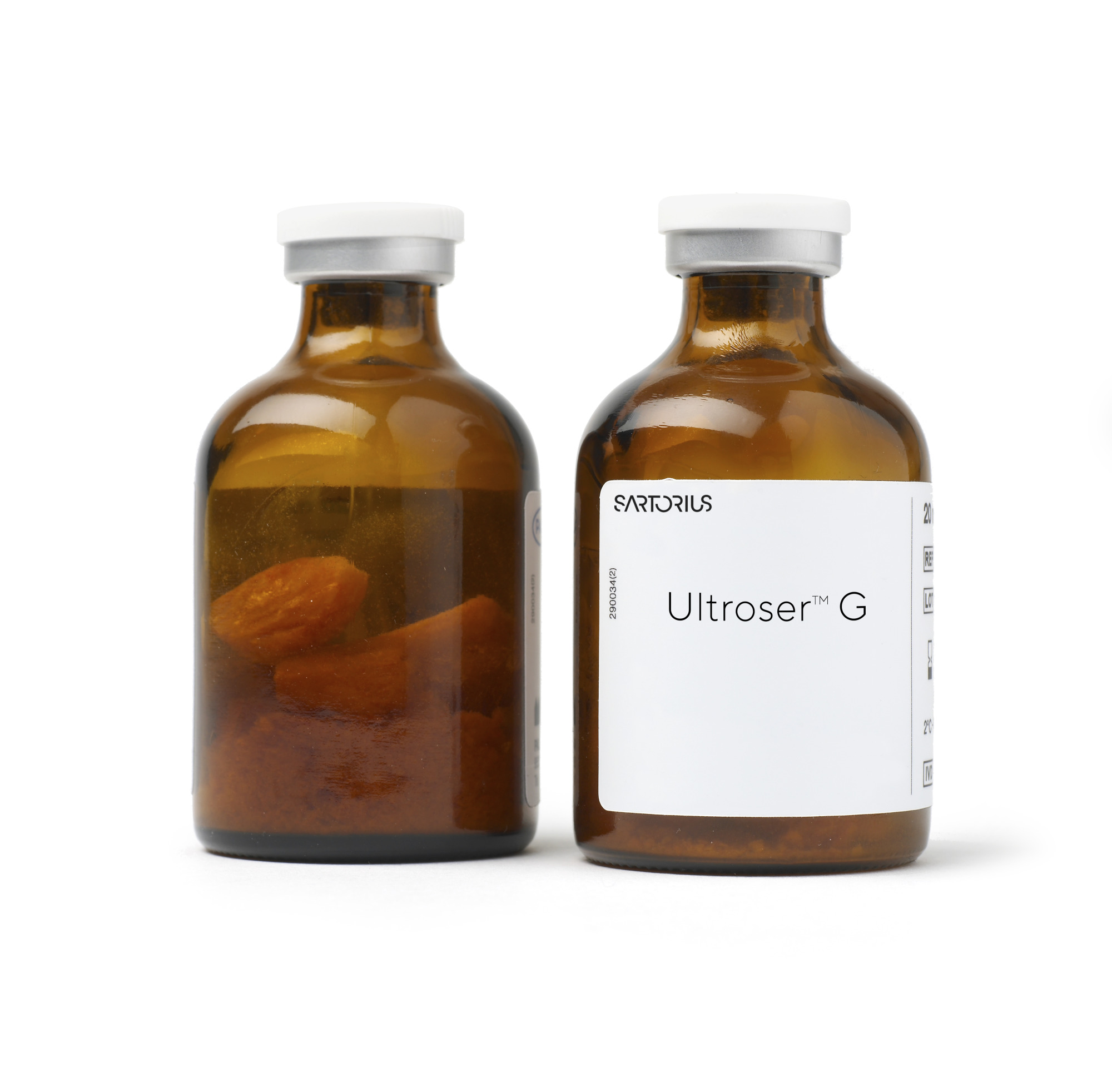
Ultroser™ G Serum Substitute
Features & Benefits:
- semi-defined composition ensuring batch-to-batch reproducibility
- low protein content
- easy use and storage
- has a concentration five times higher than fetal calf serum (2 % of reconstituted Ultroser G serum substitute is equivalent to 10% fetal calf serum in the basal medium)
- research use only (RUO) and not for use in diagnostic procedures.
Frequently asked questions
Ultroser™ G is a semi-defined serum substitute that can be used as a replacement for FCS (Fetal Calf Serum)/FBS (Fetal Bovine serum) in animal cell cultures.
As Ultroser™ G is made of biological origin materials and also chemical raw materials, it is considered a semi-defined media.
It is designed for in vitro culture of anchorage-dependent cells and is for in vitro research cell culture use only. It is not sold for manufacturing and is not for human or animal use.
The biological activity is 5 times that of FBS.
Ultroser™ G product is packaged and shipped in closed individual bottles of lyophilized powder which is reconstituted to 20 mL before use.
Ultroser™ G has some animal origin components which are from bovine and human sourced materials. The bovine origin material is derived from the blood of bovine species that originated in the United States and/or New Zealand and are free of evidence of disease. The components from bovine origin are not derived from the following parts of the cow: distal ileum of the small intestine or the tonsils from Canadian bovines of any age, or from the brain, skull, eyes, trigeminal ganglia, spinal cord, dorsal root ganglia, or vertebral column (including vertebrae of the tail, the transverse processes of the thoracic and lumbar vertebrae and the wings of the sacrum). These components were not exposed to or commingled with any other animal derived material. The rest of the components are from synthetic origin. The formulation is proprietary and
cannot be provided.
A TSE/BSE statement is not provided for in vitro research use products.
Ultroser™ G serum substitute is available as a lyophilized powder. The product is shipped at ambient temperature and must then be stored between 2° and 8° C. Once reconstituted, the solution must be used up quickly or alternatively it can be aliquoted and stored frozen at -20° C for up to 6 months. Frequent freezing and thawing must be avoided.
Ultroser™ G may be used for up to 4 years from the lyophilized date. All customers will receive a minimum of 6 months shelf life on the product.
After reconstitution, Ultroser™ G serum substitute has a biological activity 5 times greater than that of FBS. It should be used at concentrations between 0.5% and 4% (2.5% to 20% of FBS). A concentration of 2% (10% of FBS) is generally used.
To obtain a standard concentration of 2%, mix 2% Ultroser™ G serum substitute with 98% base culture medium. For each cell type, various concentrations from 0.5% to 4% will have to be evaluated to determine the optimal growth conditions. The effects on cell growth are not always proportional to the concentration of Ultroser™ G serum substitute, nor in correlation with the results obtained with FBS in the same conditions of use
The lyophilized powder is solubilized in 20 mL sterile distilled pyrogen-free water (water for injection) as follows:
1. Open the vial by breaking the tip of the capsule.
2. Introduce the appropriate volume of water using a sterile pyrogen-free pipette after first having removed the stopper
or a sterile pyrogen-free syringe by injection through the stopper. These two operations must be performed under sterile conditions.
3. Allow the lyophilizate to swell for 10 to 15 minutes. Solubilization is rapidly obtained by gently shaking the flask or by successive aspirations using a pipette or syringe. The reconstituted solution should be clear and pink coloured. For greater safety, the solution may be filtered through a sterilizing membrane of 0.2 μm pore diameter. This will not result
in any loss of activity
The culture medium may be the one generally used for culture with FBS (MEM, etc.). However, the use of an enriched medium such as HAM’s F12, DMEM, IMDM, or RPMI is recommended.
The culture support is the same as that used with FBS. Ultroser™ G serum substitute contains adhesion factors. Therefore, it can be used for pre-incubation of the plastic dishes in the medium prior to adding the cells. However, for particular cell types which are difficult to grow, it may be necessary, to improve adhesion and differentiation by coating the plastic dishes with one of the following products: poly-D-lysine, collagen, an extracellular matrix or adhesion factors such as fibronectin.
The trypsinization techniques for tissues and mono layered cells are the same as those used with FBS. However, the trypsinization period should be as short as possible, to minimize cell damage. To remove any residual trypsin, it may be necessary to add a trypsin inhibitor such as soya bean extract or aprotinin, at a concentration of 0.5 to 1 mg/mL, before dispersing the cells. If the cells still remain aggregated to each other, the cell suspension may be passed through a 40 μm cell sieve.
Two techniques may be employed for sub-culture from a medium containing FBS: Direct transfer of the cells in the medium supplemented with Ultroser™ G serum substitute or after an adaptation period by progressively reducing the quantity of serum, in several passages:
- 1st passage: 50% medium supplemented with serum (MSS) + 50% medium supplemented with Ultroser™ G serum
substitute (MSU) in the optimum concentration - 2nd passage: 25% MSS + 75% MSU
- 3rd passage: 10% MSS + 90% MSU
- 4th passage: 100% MSU
This second technique allows better adaptation of the cells to the new culture medium. Before seeding the cells, check the
pH of the final medium and, if necessary, adjust to 7.2 ± 0.1. Sodium bicarbonate or a synthetic buffer (HEPES) may be
added to improve the buffering power of the medium.
